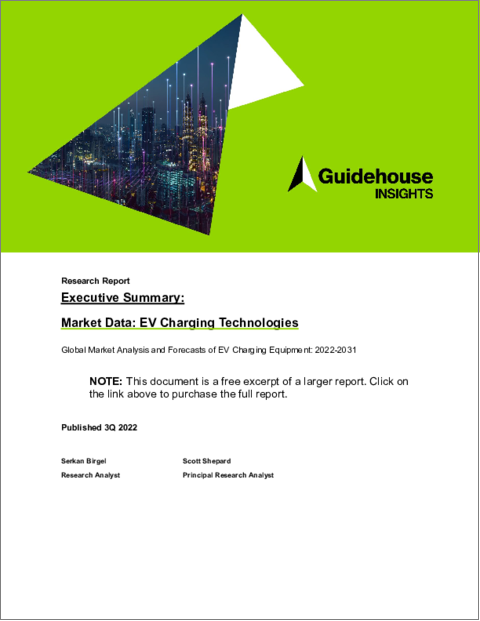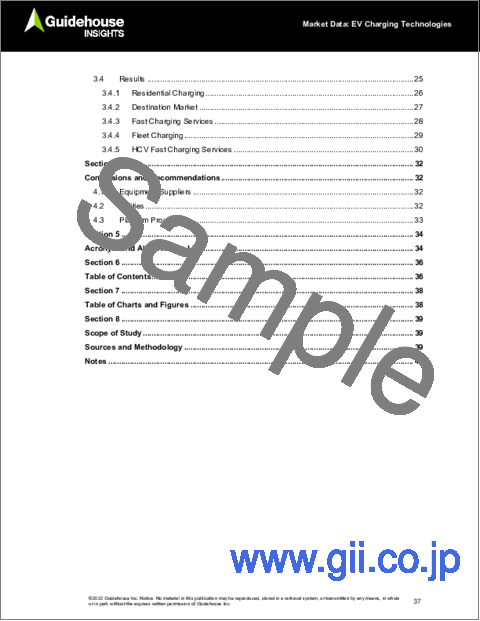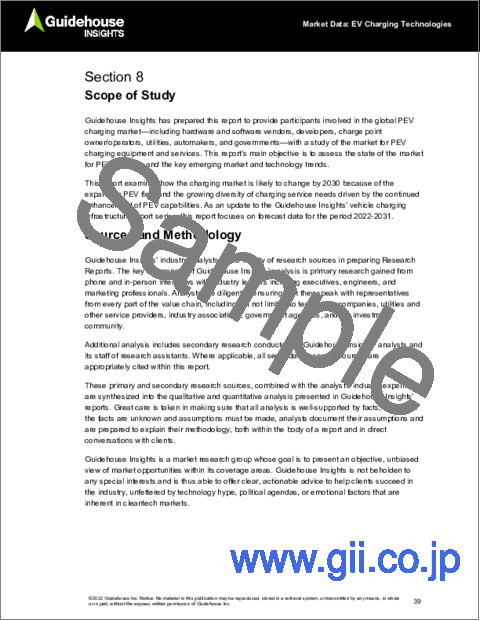|
|
市場調査レポート
商品コード
1129285
EV充電技術 - EV充電器の世界市場:分析と予測(2022年~2031年)Market Data - EV Charging Technologies - Global Market Analysis and Forecasts of EV Charging Equipment: 2022-2031 |
||||||
| EV充電技術 - EV充電器の世界市場:分析と予測(2022年~2031年) |
|
出版日: 2022年09月29日
発行: Guidehouse Insights
ページ情報: 英文 41 Pages; 45 Tables, Charts & Figures
納期: 即納可能
|
- 全表示
- 概要
- 図表
- 目次
当レポートでは、EV充電技術 - EV充電器市場について調査し、市場の問題、促進要因、障壁、市場予測などの包括的な情報を提供しています。
目次
第1章 エグゼクティブサマリー
- イントロダクション
- 範囲
- 市場の見通し
第2章 市場の問題
- EV充電技術
- AC充電
- DC充電
- パンタグラフ充電
- ワイヤレス充電
- バッテリースワップ
- 用途
- 住宅用
- 目的地
- 急速充電サービス
- フリート
- HCV急速充電サービス
- 市場促進要因
- 政府の方針
- 利害関係者の投資
- 市場の課題
- 標準化
- 現行のグリッド構造
第3章 市場予測
- 範囲
- 調査手法
- 主な前提条件
- 結果
- 住宅用充電
LIST OF CHARTS AND FIGURES
- Charging Technology Revenue by Region, World Markets: 2022-2031
- Charging Technology Revenue by Charging Application, World Markets: 2022-2031
- Charging Technology Revenue by Segment, World Markets: 2022-2031
- Residential Charge Point Revenue by Segment, World Markets: 2022-2031
- Destination Charge Point Revenue by Segment, World Markets: 2022-2031
- Fast Charging Service Revenue by Segment, World Markets: 2022-2031
- Fleet Charge Point Revenue by Segment, World Markets: 2022-2031
- HCV Fast Charge Service Revenue by Segment, World Markets: 2022-2031
- Regional Forecast Segmentations
LIST OF TABLES
- Light Duty EVs in Use by Region, World Markets: 2022-2031
- Heavy Commercial EVs in Use by Region, World Markets: 2022-2031
- Charge-Points (Including Cord Sets) Deployed by Region, World Markets: 2022-2031
- Charge-Point Sales by Region, World Markets: 2022-2031
- Residential Charge-Points (Including Cord Sets) Deployed by Region, World Markets: 2022-2031
- Destination Charge-Points Deployed by Region, World Markets: 2022-2031
- Fast Charge Service Charge-Points Deployed by Region, World Markets: 2022-2031
- Fleet Charge-Points Deployed by Region, World Markets: 2022-2031
- HCV Fast Charge Service Charge-Points Deployed by Region, World Markets: 2022-2031
- Residential Charge-Point Sales by Region, World Markets: 2022-2031
- Destination Charge-Point Sales by Region, World Markets: 2022-2031
- Fast Charge Service Charge-Points Sales by Region, World Markets: 2022-2031
- Fleet Charge-Point Sales by Region, World Markets: 2022-2031
- HCV Fast Charge Service Charge-Point Sales by Region, World Markets: 2022-2031
- L1 Charge-Point Sales by Region, World Markets: 2022-2031
- L2 Charge-Point Sales by Region, World Markets: 2022-2031
- L3 AC Charge-Point Sales by Region, World Markets: 2022-2031
- DC >25 kW Charge-Point Sales by Region, World Markets: 2022-2031
- DC 50 kW-250 kW Charge-Point Sales by Region, World Markets: 2022-2031
- DC 250 kW-400 kW Charge-Point Sales by Region, World Markets: 2022-2031
- DC <400 kW Charge-Point Sales by Region, World Markets: 2022-2031
- Pantograph >150 kW Sales by Region, World Markets: 2022-2031
- Pantograph <150 kW Sales by Region, World Markets: 2022-2031
- Wireless >22 kW Charge-Point Sales by Region, World Markets: 2022-2031
- Wireless <22 kW Charge-Point Sales by Region, World Markets: 2022-2031
- Swap Stations Deployments by Region, World Markets: 2022-2031
- Charge-Point Hardware Revenue by Region, World Markets: 2022-2031
- Charge-Point Installation Revenue by Region, World Markets: 2022-2031
- Charge-Point Operations Revenue by Region, World Markets: 2022-2031
- Charge-Point Maintenance Revenue by Region, World Markets: 2022-2031
- Vehicle Grid Integration Revenue by Region, World Markets: 2022-2031
- Charge-Point Revenue by Application, World Markets: 2022-2031
- Hardware Revenue by Technology, World Markets: 2022-2031
- AC Connection Standards and Power Levels
- Regional DC Connection Standards
- Cost per Charge Point Deployment by Technology
Electrification of the transport sector is a cornerstone of the energy transition. Driven by policy-maker imperatives and the public's growing climate-consciousness, the availability of EV charging technology is key to electrifying transport. A growing number of government targets for internal combustion engine (ICE) bans and corporate targets for supply chain decarbonization have prompted fleets and automakers to announce that they will abandon the ICE within the next 5 to 15 years. None of these initiatives are new, but the industry-wide recognition of the magnitude of these demands is.
The US Bipartisan Infrastructure Law provides nearly $5 billion to support establishing a 500,000-station EV charging infrastructure along designated Alternative Fuel Corridors and the Inflation Reduction Act will provide tax credits for the purchase of EVs (medium and heavy duty vehicles), and the purchase and installation of related charging infrastructure. The European Union's Green Deal, announced in December 2019, targets one million charging points by 2025 to reduce greenhouse gas emissions from transport by 90% compared to 1990 levels. The UK and various countries on the European continent have introduced national, regional, and city level incentive schemes, targeting the uptake of EVs and other alternative fuel vehicles as well as a charging infrastructure.
This report provides an overview of the technologies and applications that make up the global EV charging market, identifies forces driving and challenging the market, and provides Guidehouse Insights' market forecasts to 2031. It focuses on five technology groups (AC, DC, pantograph, wireless, and battery swapping) and five charging applications (residential, destination, fast charging services, fleet, and heavy commercial vehicle [HCV] fast charging services).
KEY QUESTIONS ADDRESSED:
- What are the key segmentations and latest developments within the key sectors of the EV charging market?
- What are the key forecasts for residential, destination, fast charging services, fleet, and HCV fast charging services?
- What are the key forecasts for AC, DC, wireless, pantograph, and swap station technologies?
- What are the key forecasts for charging technology revenue, across equipment, installation, operations, maintenance, and vehicle grid integration?
- How will EV charging technology deployments change across key world regions?
WHO NEEDS THIS REPORT:
- EV supply equipment (EVSE) manufacturers and service providers
- Charging equipment component suppliers
- Automotive manufacturers and suppliers
- Network and software developers
- Utilities
- Government agencies
- Industry associations
- Investor community
Table of Contents
1. Executive Summary
- 1.1. Introduction
- 1.2. Scope
- 1.3. Market Outlook
2. Market Issues
- 2.1. EV Charging Technologies
- 2.1.1. AC Charging
- 2.1.2. DC Charging
- 2.1.3. Pantograph Charging
- 2.1.4. Wireless Charging
- 2.1.5. Battery Swapping
- 2.2. Applications
- 2.2.1. Residential
- 2.2.2. Destination
- 2.2.3. Fast Charging Services
- 2.2.4. Fleet
- 2.2.5. HCV Fast Charging Services
- 2.3. Market Drivers
- 2.3.1. Government Policy
- 2.3.2. Stakeholder Investments
- 2.4. Market Challenges
- 2.4.1. Standardization
- 2.4.2. Incumbent Grid Structures
3. Market Forecasts
- 3.1. Scope
- 3.2. Methodology
- 3.3. Key Assumptions
- 3.4. Results
- 3.4.1. Residential Charging
- 3.4.2. Destination Market
- 3.4.3. Fast Charging Services
- 3.4.4. Fleet Charging
- 3.4.5. HCV Fast Charging Services
4. Conclusions and Recommendations
- 4.1. Equipment Suppliers
- 4.2. Utilities
- 4.3. Platform Providers




